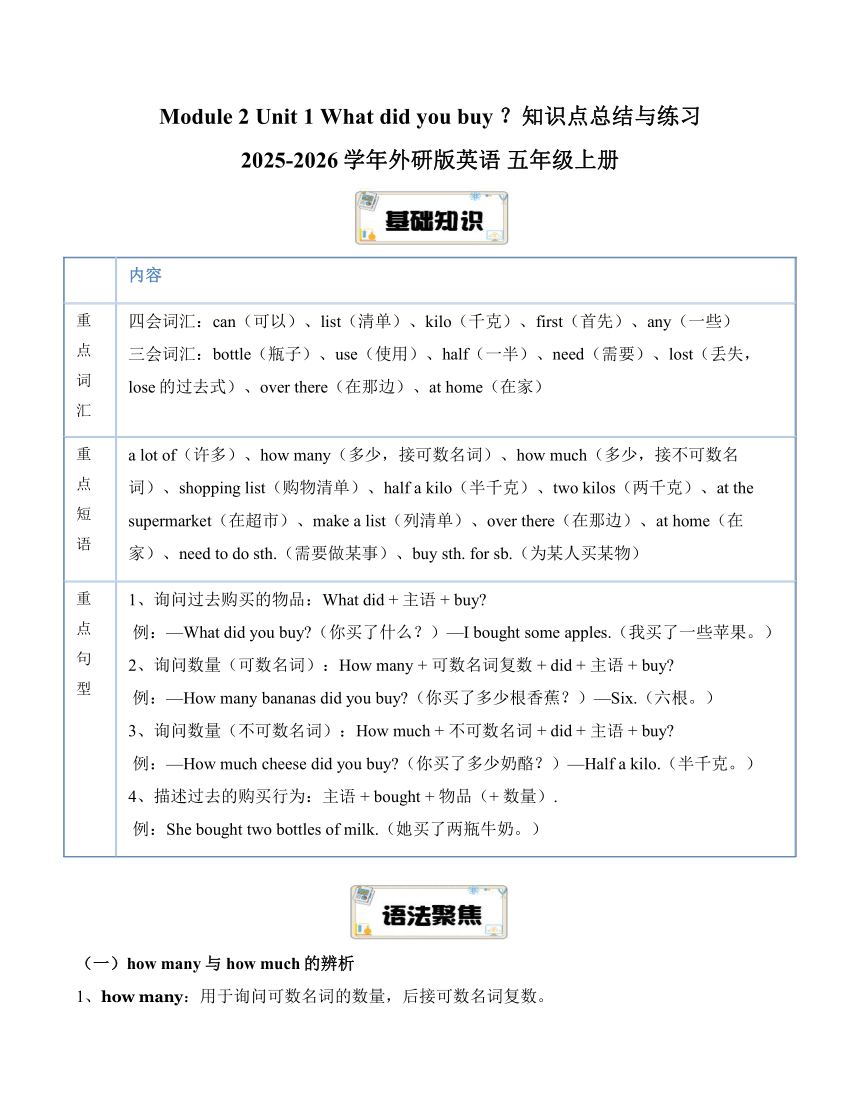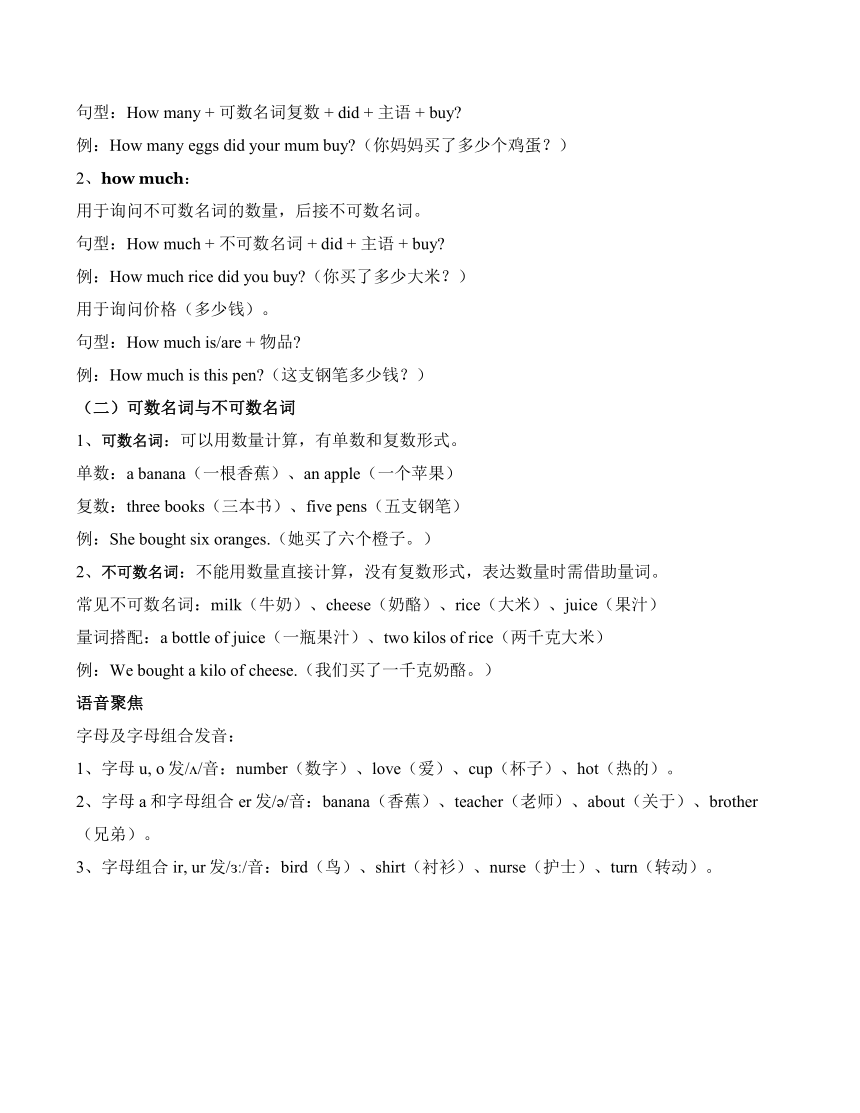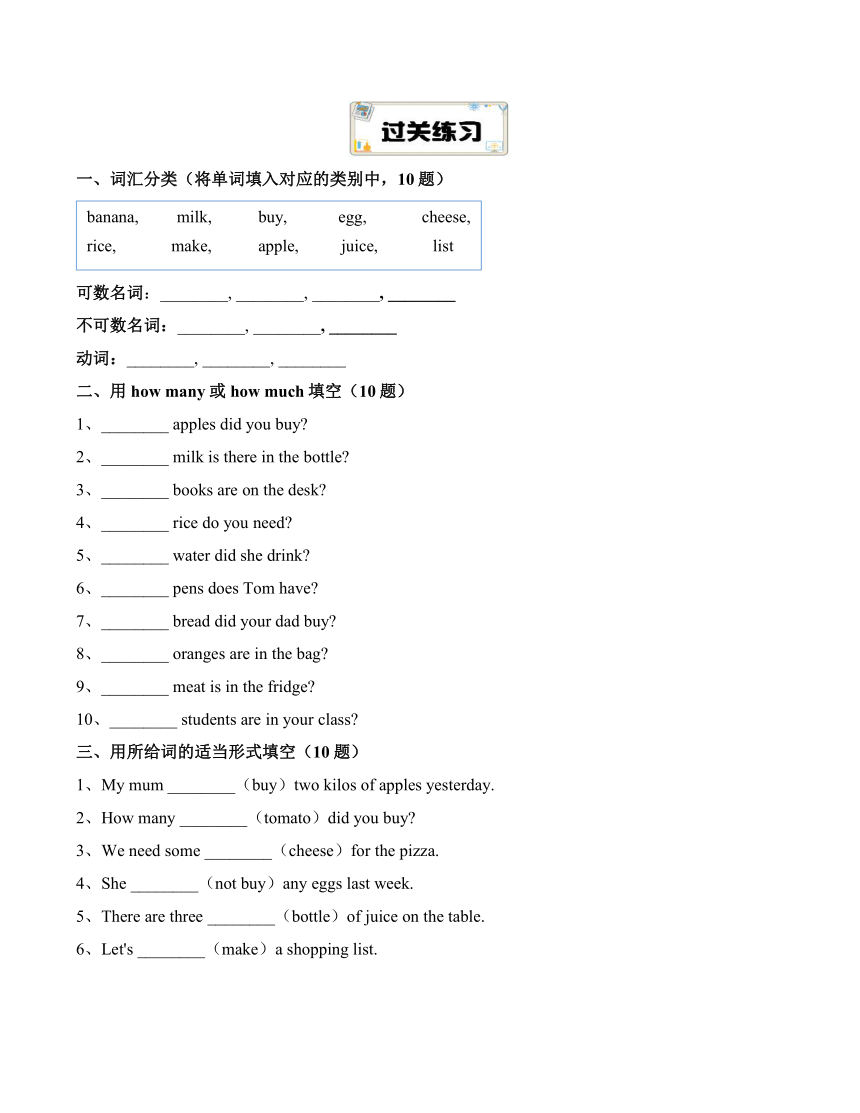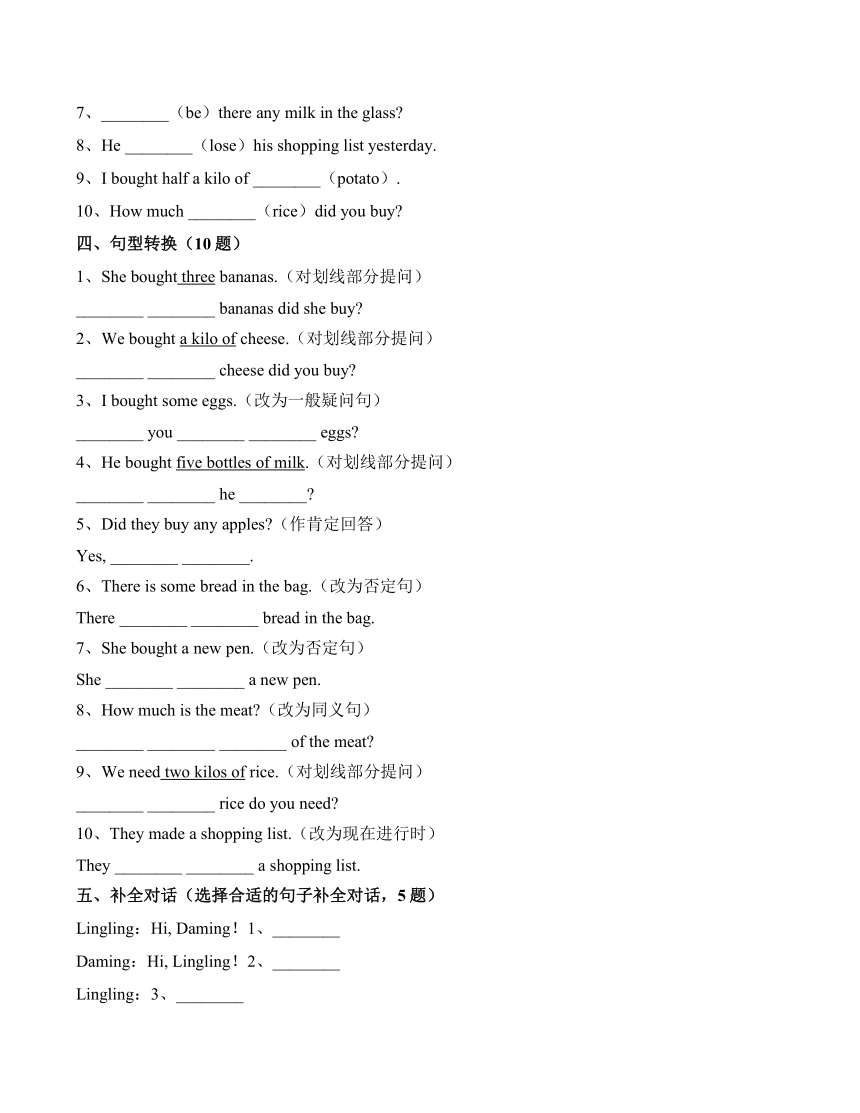Module 2 Unit 1 What did you buy 知识点总结与练习(含答案)
文档属性
| 名称 | Module 2 Unit 1 What did you buy 知识点总结与练习(含答案) |  | |
| 格式 | docx | ||
| 文件大小 | 52.0KB | ||
| 资源类型 | 试卷 | ||
| 版本资源 | 外研版(三年级起点) | ||
| 科目 | 英语 | ||
| 更新时间 | 2025-07-19 08:46:00 | ||
图片预览




文档简介
Module 2 Unit 1 What did you buy ?知识点总结与练习
2025-2026学年外研版英语 五年级上册
内容
重点词汇 四会词汇:can(可以)、list(清单)、kilo(千克)、first(首先)、any(一些) 三会词汇:bottle(瓶子)、use(使用)、half(一半)、need(需要)、lost(丢失,lose的过去式)、over there(在那边)、at home(在家)
重点短语 a lot of(许多)、how many(多少,接可数名词)、how much(多少,接不可数名词)、shopping list(购物清单)、half a kilo(半千克)、two kilos(两千克)、at the supermarket(在超市)、make a list(列清单)、over there(在那边)、at home(在家)、need to do sth.(需要做某事)、buy sth. for sb.(为某人买某物)
重点句型 1、询问过去购买的物品:What did + 主语 + buy 例:—What did you buy (你买了什么?)—I bought some apples.(我买了一些苹果。) 2、询问数量(可数名词):How many + 可数名词复数 + did + 主语 + buy 例:—How many bananas did you buy (你买了多少根香蕉?)—Six.(六根。) 3、询问数量(不可数名词):How much + 不可数名词 + did + 主语 + buy 例:—How much cheese did you buy (你买了多少奶酪?)—Half a kilo.(半千克。) 4、描述过去的购买行为:主语 + bought + 物品(+ 数量). 例:She bought two bottles of milk.(她买了两瓶牛奶。)
(一)how many与how much的辨析
1、how many:用于询问可数名词的数量,后接可数名词复数。
句型:How many + 可数名词复数 + did + 主语 + buy
例:How many eggs did your mum buy (你妈妈买了多少个鸡蛋?)
2、how much:
用于询问不可数名词的数量,后接不可数名词。
句型:How much + 不可数名词 + did + 主语 + buy
例:How much rice did you buy (你买了多少大米?)
用于询问价格(多少钱)。
句型:How much is/are + 物品
例:How much is this pen (这支钢笔多少钱?)
(二)可数名词与不可数名词
1、可数名词:可以用数量计算,有单数和复数形式。
单数:a banana(一根香蕉)、an apple(一个苹果)
复数:three books(三本书)、five pens(五支钢笔)
例:She bought six oranges.(她买了六个橙子。)
2、不可数名词:不能用数量直接计算,没有复数形式,表达数量时需借助量词。
常见不可数名词:milk(牛奶)、cheese(奶酪)、rice(大米)、juice(果汁)
量词搭配:a bottle of juice(一瓶果汁)、two kilos of rice(两千克大米)
例:We bought a kilo of cheese.(我们买了一千克奶酪。)
语音聚焦
字母及字母组合发音:
1、字母u, o发/ /音:number(数字)、love(爱)、cup(杯子)、hot(热的)。
2、字母a和字母组合er发/ /音:banana(香蕉)、teacher(老师)、about(关于)、brother(兄弟)。
3、字母组合ir, ur发/ /音:bird(鸟)、shirt(衬衫)、nurse(护士)、turn(转动)。
一、词汇分类(将单词填入对应的类别中,10题)
可数名词:________, ________, ________, ________
不可数名词:________, ________, ________
动词:________, ________, ________
二、用how many或how much填空(10题)
1、________ apples did you buy
2、________ milk is there in the bottle
3、________ books are on the desk
4、________ rice do you need
5、________ water did she drink
6、________ pens does Tom have
7、________ bread did your dad buy
8、________ oranges are in the bag
9、________ meat is in the fridge
10、________ students are in your class
三、用所给词的适当形式填空(10题)
1、My mum ________(buy)two kilos of apples yesterday.
2、How many ________(tomato)did you buy
3、We need some ________(cheese)for the pizza.
4、She ________(not buy)any eggs last week.
5、There are three ________(bottle)of juice on the table.
6、Let's ________(make)a shopping list.
7、________(be)there any milk in the glass
8、He ________(lose)his shopping list yesterday.
9、I bought half a kilo of ________(potato).
10、How much ________(rice)did you buy
四、句型转换(10题)
1、She bought three bananas.(对划线部分提问)
________ ________ bananas did she buy
2、We bought a kilo of cheese.(对划线部分提问)
________ ________ cheese did you buy
3、I bought some eggs.(改为一般疑问句)
________ you ________ ________ eggs
4、He bought five bottles of milk.(对划线部分提问)
________ ________ he ________
5、Did they buy any apples (作肯定回答)
Yes, ________ ________.
6、There is some bread in the bag.(改为否定句)
There ________ ________ bread in the bag.
7、She bought a new pen.(改为否定句)
She ________ ________ a new pen.
8、How much is the meat (改为同义句)
________ ________ ________ of the meat
9、We need two kilos of rice.(对划线部分提问)
________ ________ rice do you need
10、They made a shopping list.(改为现在进行时)
They ________ ________ a shopping list.
五、补全对话(选择合适的句子补全对话,5题)
Lingling:Hi, Daming!1、________
Daming:Hi, Lingling!2、________
Lingling:3、________
Daming:I bought six apples.
Lingling:4、________
Daming:5、________
Lingling:Let's make a fruit salad.
Daming:Good idea!
六、阅读理解(5题)
A Shopping List
Last Sunday, Lucy went shopping with her mum. They made a shopping list first. The list was: three apples, two bananas, a kilo of cheese, half a kilo of meat and four bottles of milk.
They went to the supermarket by bus. Lucy helped her mum carry the basket. They bought all the things on the list. The apples were 5 yuan, the bananas were 3 yuan, the cheese was 12 yuan, the meat was 20 yuan and the milk was 8 yuan. They paid 48 yuan in total. They went home happily.
1、When did Lucy go shopping
A. Last Saturday. B. Last Sunday. C. Yesterday.
2、What was on the shopping list
A. Apples, bananas, cheese, meat and milk.
B. Apples, oranges, cheese, meat and juice.
C. Bananas, eggs, cheese, bread and milk.
3、How many apples did they buy
A. Two. B. Three. C. Four.
4、How much was the cheese
A. 12 yuan. B. 20 yuan. C. 8 yuan.
5、How did they go to the supermarket
A. By car. B. On foot. C. By bus.
七、书面表达(1题)
请以“My Shopping List”为题,根据表格信息写一篇短文,描述你和妈妈的购物清单及购买情况。
物品 数量
苹果 5个
牛奶 3瓶
奶酪 1千克
香蕉 4根
答案及解析
一、词汇分类
可数名词:banana, egg, apple, list
不可数名词:milk, cheese, rice, juice
动词:buy, make
【解析】可数名词有单复数形式,不可数名词无复数形式,动词表示动作行为。
二、用how many或how much填空
1、How many(解析:apples为可数名词复数,用how many提问数量)
2、How much(解析:milk为不可数名词,用how much提问数量)
3、How many(解析:books为可数名词复数,用how many提问数量)
4、How much(解析:rice为不可数名词,用how much提问数量)
5、How much(解析:water为不可数名词,用how much提问数量)
6、How many(解析:pens为可数名词复数,用how many提问数量)
7、How much(解析:bread为不可数名词,用how much提问数量)
8、How many(解析:oranges为可数名词复数,用how many提问数量)
9、How much(解析:meat为不可数名词,用how much提问数量)
10、How many(解析:students为可数名词复数,用how many提问数量)
三、用所给词的适当形式填空
1、bought(解析:yesterday提示一般过去时,buy的过去式为bought)
2、tomatoes(解析:how many后接可数名词复数,tomato的复数形式为tomatoes)
3、cheese(解析:cheese为不可数名词,无复数形式)
4、didn't buy(解析:last week提示一般过去时,否定句用“didn't+动词原形”)
5、bottles(解析:three后接可数名词复数,bottle的复数形式为bottles)
6、make(解析:Let's后接动词原形)
7、Is(解析:milk为不可数名词,be动词用is)
8、lost(解析:yesterday提示一般过去时,lose的过去式为lost)
9、potatoes(解析:half a kilo of后接可数名词复数,potato的复数形式为potatoes)
10、rice(解析:rice为不可数名词,无复数形式)
四、句型转换
1、How many(解析:对可数名词数量提问用how many)
2、How much(解析:对不可数名词数量提问用how much)
3、Did;buy any(解析:一般过去时一般疑问句用Did开头,some变any)
4、What did;buy(解析:对物品提问用what,一般过去时借助did,动词用原形)
5、they did(解析:Did引导的一般疑问句肯定回答为“Yes, 主语+did”)
6、isn't any(解析:否定句中some变any,be动词后加not)
7、didn't buy(解析:一般过去时否定句用“didn't+动词原形”)
8、What's the price(解析:询问价格的同义表达为“What's the price of...”)
9、How much(解析:对不可数名词数量提问用how much)
10、are making(解析:现在进行时结构为“be动词+动词-ing形式”)
五、补全对话
1、C(解析:由下文回答购买的物品可知,此处询问“在超市买了什么”)
2、B(解析:回应上文提问,说明购买的物品)
3、A(解析:由下文回答苹果的数量可知,此处询问“买了多少个苹果”)
4、E(解析:由下文回答奶酪的数量可知,此处询问“买了多少奶酪”)
5、D(解析:回应上文对不可数名词数量的提问,用“Half a kilo”表示半千克)
六、阅读理解
1、B(解析:文中明确提到“Last Sunday, Lucy went shopping with her mum”)
2、A(解析:购物清单包含“three apples, two bananas, a kilo of cheese, half a kilo of meat and four bottles of milk”)
3、B(解析:文中提到清单上有“three apples”,即买了3个苹果)
4、A(解析:文中明确说明“the cheese was 12 yuan”)
5、C(解析:由“They went to the supermarket by bus”可知交通方式为乘公交车)
七、书面表达(参考范文)
My Shopping List
Yesterday, my mum and I went to the supermarket. We made a shopping list before going. We bought five apples, four bananas, one kilo of cheese and three bottles of milk. The apples were fresh, and the bananas were sweet. We carried the things home together. It was a happy day.
【解析】围绕购物清单描述购买的物品及数量,使用一般过去时,符合单元主题和要求。
2025-2026学年外研版英语 五年级上册
内容
重点词汇 四会词汇:can(可以)、list(清单)、kilo(千克)、first(首先)、any(一些) 三会词汇:bottle(瓶子)、use(使用)、half(一半)、need(需要)、lost(丢失,lose的过去式)、over there(在那边)、at home(在家)
重点短语 a lot of(许多)、how many(多少,接可数名词)、how much(多少,接不可数名词)、shopping list(购物清单)、half a kilo(半千克)、two kilos(两千克)、at the supermarket(在超市)、make a list(列清单)、over there(在那边)、at home(在家)、need to do sth.(需要做某事)、buy sth. for sb.(为某人买某物)
重点句型 1、询问过去购买的物品:What did + 主语 + buy 例:—What did you buy (你买了什么?)—I bought some apples.(我买了一些苹果。) 2、询问数量(可数名词):How many + 可数名词复数 + did + 主语 + buy 例:—How many bananas did you buy (你买了多少根香蕉?)—Six.(六根。) 3、询问数量(不可数名词):How much + 不可数名词 + did + 主语 + buy 例:—How much cheese did you buy (你买了多少奶酪?)—Half a kilo.(半千克。) 4、描述过去的购买行为:主语 + bought + 物品(+ 数量). 例:She bought two bottles of milk.(她买了两瓶牛奶。)
(一)how many与how much的辨析
1、how many:用于询问可数名词的数量,后接可数名词复数。
句型:How many + 可数名词复数 + did + 主语 + buy
例:How many eggs did your mum buy (你妈妈买了多少个鸡蛋?)
2、how much:
用于询问不可数名词的数量,后接不可数名词。
句型:How much + 不可数名词 + did + 主语 + buy
例:How much rice did you buy (你买了多少大米?)
用于询问价格(多少钱)。
句型:How much is/are + 物品
例:How much is this pen (这支钢笔多少钱?)
(二)可数名词与不可数名词
1、可数名词:可以用数量计算,有单数和复数形式。
单数:a banana(一根香蕉)、an apple(一个苹果)
复数:three books(三本书)、five pens(五支钢笔)
例:She bought six oranges.(她买了六个橙子。)
2、不可数名词:不能用数量直接计算,没有复数形式,表达数量时需借助量词。
常见不可数名词:milk(牛奶)、cheese(奶酪)、rice(大米)、juice(果汁)
量词搭配:a bottle of juice(一瓶果汁)、two kilos of rice(两千克大米)
例:We bought a kilo of cheese.(我们买了一千克奶酪。)
语音聚焦
字母及字母组合发音:
1、字母u, o发/ /音:number(数字)、love(爱)、cup(杯子)、hot(热的)。
2、字母a和字母组合er发/ /音:banana(香蕉)、teacher(老师)、about(关于)、brother(兄弟)。
3、字母组合ir, ur发/ /音:bird(鸟)、shirt(衬衫)、nurse(护士)、turn(转动)。
一、词汇分类(将单词填入对应的类别中,10题)
可数名词:________, ________, ________, ________
不可数名词:________, ________, ________
动词:________, ________, ________
二、用how many或how much填空(10题)
1、________ apples did you buy
2、________ milk is there in the bottle
3、________ books are on the desk
4、________ rice do you need
5、________ water did she drink
6、________ pens does Tom have
7、________ bread did your dad buy
8、________ oranges are in the bag
9、________ meat is in the fridge
10、________ students are in your class
三、用所给词的适当形式填空(10题)
1、My mum ________(buy)two kilos of apples yesterday.
2、How many ________(tomato)did you buy
3、We need some ________(cheese)for the pizza.
4、She ________(not buy)any eggs last week.
5、There are three ________(bottle)of juice on the table.
6、Let's ________(make)a shopping list.
7、________(be)there any milk in the glass
8、He ________(lose)his shopping list yesterday.
9、I bought half a kilo of ________(potato).
10、How much ________(rice)did you buy
四、句型转换(10题)
1、She bought three bananas.(对划线部分提问)
________ ________ bananas did she buy
2、We bought a kilo of cheese.(对划线部分提问)
________ ________ cheese did you buy
3、I bought some eggs.(改为一般疑问句)
________ you ________ ________ eggs
4、He bought five bottles of milk.(对划线部分提问)
________ ________ he ________
5、Did they buy any apples (作肯定回答)
Yes, ________ ________.
6、There is some bread in the bag.(改为否定句)
There ________ ________ bread in the bag.
7、She bought a new pen.(改为否定句)
She ________ ________ a new pen.
8、How much is the meat (改为同义句)
________ ________ ________ of the meat
9、We need two kilos of rice.(对划线部分提问)
________ ________ rice do you need
10、They made a shopping list.(改为现在进行时)
They ________ ________ a shopping list.
五、补全对话(选择合适的句子补全对话,5题)
Lingling:Hi, Daming!1、________
Daming:Hi, Lingling!2、________
Lingling:3、________
Daming:I bought six apples.
Lingling:4、________
Daming:5、________
Lingling:Let's make a fruit salad.
Daming:Good idea!
六、阅读理解(5题)
A Shopping List
Last Sunday, Lucy went shopping with her mum. They made a shopping list first. The list was: three apples, two bananas, a kilo of cheese, half a kilo of meat and four bottles of milk.
They went to the supermarket by bus. Lucy helped her mum carry the basket. They bought all the things on the list. The apples were 5 yuan, the bananas were 3 yuan, the cheese was 12 yuan, the meat was 20 yuan and the milk was 8 yuan. They paid 48 yuan in total. They went home happily.
1、When did Lucy go shopping
A. Last Saturday. B. Last Sunday. C. Yesterday.
2、What was on the shopping list
A. Apples, bananas, cheese, meat and milk.
B. Apples, oranges, cheese, meat and juice.
C. Bananas, eggs, cheese, bread and milk.
3、How many apples did they buy
A. Two. B. Three. C. Four.
4、How much was the cheese
A. 12 yuan. B. 20 yuan. C. 8 yuan.
5、How did they go to the supermarket
A. By car. B. On foot. C. By bus.
七、书面表达(1题)
请以“My Shopping List”为题,根据表格信息写一篇短文,描述你和妈妈的购物清单及购买情况。
物品 数量
苹果 5个
牛奶 3瓶
奶酪 1千克
香蕉 4根
答案及解析
一、词汇分类
可数名词:banana, egg, apple, list
不可数名词:milk, cheese, rice, juice
动词:buy, make
【解析】可数名词有单复数形式,不可数名词无复数形式,动词表示动作行为。
二、用how many或how much填空
1、How many(解析:apples为可数名词复数,用how many提问数量)
2、How much(解析:milk为不可数名词,用how much提问数量)
3、How many(解析:books为可数名词复数,用how many提问数量)
4、How much(解析:rice为不可数名词,用how much提问数量)
5、How much(解析:water为不可数名词,用how much提问数量)
6、How many(解析:pens为可数名词复数,用how many提问数量)
7、How much(解析:bread为不可数名词,用how much提问数量)
8、How many(解析:oranges为可数名词复数,用how many提问数量)
9、How much(解析:meat为不可数名词,用how much提问数量)
10、How many(解析:students为可数名词复数,用how many提问数量)
三、用所给词的适当形式填空
1、bought(解析:yesterday提示一般过去时,buy的过去式为bought)
2、tomatoes(解析:how many后接可数名词复数,tomato的复数形式为tomatoes)
3、cheese(解析:cheese为不可数名词,无复数形式)
4、didn't buy(解析:last week提示一般过去时,否定句用“didn't+动词原形”)
5、bottles(解析:three后接可数名词复数,bottle的复数形式为bottles)
6、make(解析:Let's后接动词原形)
7、Is(解析:milk为不可数名词,be动词用is)
8、lost(解析:yesterday提示一般过去时,lose的过去式为lost)
9、potatoes(解析:half a kilo of后接可数名词复数,potato的复数形式为potatoes)
10、rice(解析:rice为不可数名词,无复数形式)
四、句型转换
1、How many(解析:对可数名词数量提问用how many)
2、How much(解析:对不可数名词数量提问用how much)
3、Did;buy any(解析:一般过去时一般疑问句用Did开头,some变any)
4、What did;buy(解析:对物品提问用what,一般过去时借助did,动词用原形)
5、they did(解析:Did引导的一般疑问句肯定回答为“Yes, 主语+did”)
6、isn't any(解析:否定句中some变any,be动词后加not)
7、didn't buy(解析:一般过去时否定句用“didn't+动词原形”)
8、What's the price(解析:询问价格的同义表达为“What's the price of...”)
9、How much(解析:对不可数名词数量提问用how much)
10、are making(解析:现在进行时结构为“be动词+动词-ing形式”)
五、补全对话
1、C(解析:由下文回答购买的物品可知,此处询问“在超市买了什么”)
2、B(解析:回应上文提问,说明购买的物品)
3、A(解析:由下文回答苹果的数量可知,此处询问“买了多少个苹果”)
4、E(解析:由下文回答奶酪的数量可知,此处询问“买了多少奶酪”)
5、D(解析:回应上文对不可数名词数量的提问,用“Half a kilo”表示半千克)
六、阅读理解
1、B(解析:文中明确提到“Last Sunday, Lucy went shopping with her mum”)
2、A(解析:购物清单包含“three apples, two bananas, a kilo of cheese, half a kilo of meat and four bottles of milk”)
3、B(解析:文中提到清单上有“three apples”,即买了3个苹果)
4、A(解析:文中明确说明“the cheese was 12 yuan”)
5、C(解析:由“They went to the supermarket by bus”可知交通方式为乘公交车)
七、书面表达(参考范文)
My Shopping List
Yesterday, my mum and I went to the supermarket. We made a shopping list before going. We bought five apples, four bananas, one kilo of cheese and three bottles of milk. The apples were fresh, and the bananas were sweet. We carried the things home together. It was a happy day.
【解析】围绕购物清单描述购买的物品及数量,使用一般过去时,符合单元主题和要求。
同课章节目录
- Module 1
- Unit 1 Did you come back yesterday?
- Unit 2 We bought ice creams.
- Module 2
- Unit 1 What did you buy?
- Unit 2 How much cheese did you buy?
- Module 3
- Unit 1 Where did you go?
- Unit 2 Daming took a photo of his father.
- Module 4
- Unit 1 Mum bought a new T-shirt for me.
- Unit 2 What's the matter with Daming?
- Module 5
- Unit 1 There are only nineteen crayons
- Unit 2 There are forty.
- Module 6
- Unit 1 You can play football well.
- Unit 2 He ran very fast.
- Module 7
- Unit 1 He can't see.
- Unit 2 This little girl can't walk.
- Module 8
- Unit 1 What time does your school start?
- Unit 2 Yesterday I went to Sam and Amy's school.
- Module 9
- Unit 1 Are you feeling bored?
- Unit 2 I feel happy.
- Review Module
- Unit 1
- Unit 2
- Module 10
- Unit 1 He was in the kitchen.
- Unit 2 Don't shout, please!
- 旧版资料
- Module 1 London
- Module 2 Shopping
- Module 3 At the Weekend
- Module 4 Possession
- Module 5 In Class
- Module 6 Self-assessment
- Module 7 Community
- Module 8 School
- Module 9 Feelings
- Module 10 Manners
- Review Module
